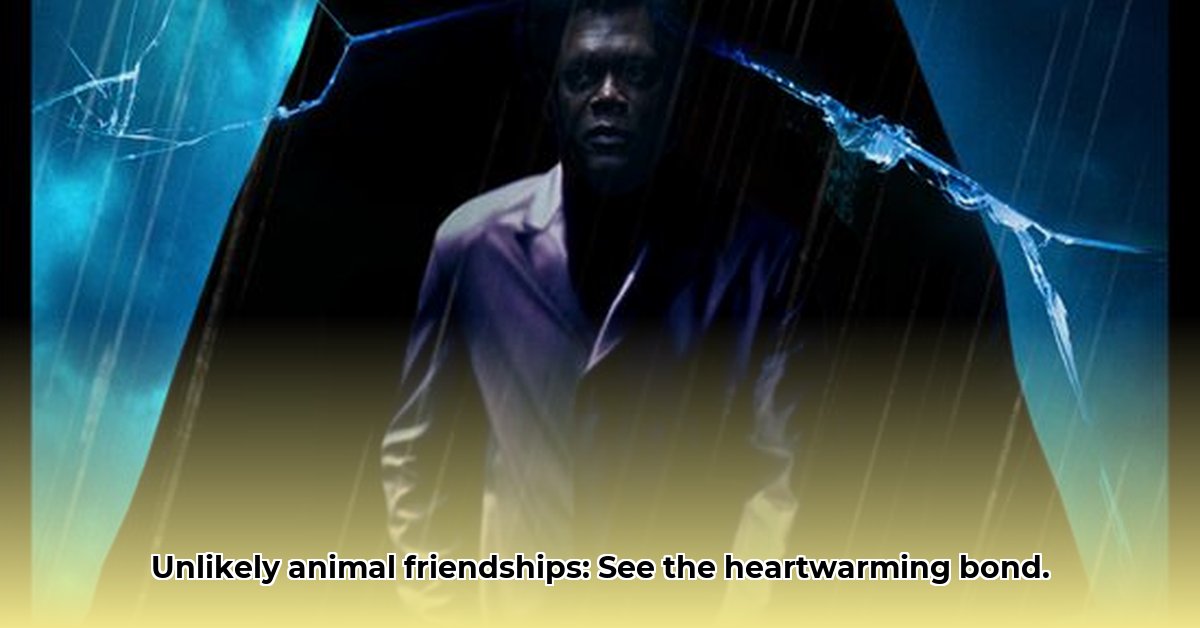Forget the usual nature documentaries showing fierce competition! Dive into the heartwarming world of unlikely animal best friends: lions and dogs, elephants and dogs, even hippos and tortoises. We’ll explore how these amazing cross-species friendships work, why they form, and what we can learn from them. From adorable puppies bonding with majestic lions to elephants and canine companions, these stories reveal a surprising and touching side of the animal kingdom. Prepare to have your perceptions of animal behavior challenged and warmed by this journey into interspecies friendships—friendships that hold profound significance for animals and, perhaps, for us too. To learn more about animal emotions, check out this article on animal sentience.
Defying Nature’s Script: Unlikely Animal Partnerships
Have you ever witnessed a lion napping peacefully beside a dog, or an elephant gently interacting with a small dog? These aren’t scenes from a fantasy film; they’re real friendships that defy the usual “predator-prey” script of nature. These amazing animal partnerships demonstrate that nature’s rules aren’t always rigid, and unexpected bonds can blossom in the most unlikely of places. Let’s explore these incredible connections that challenge our understanding of the animal world. Considering the typical competition for resources and survival, what underlying mechanisms drive these seemingly impossible connections?
1. Lions and Dogs: An Unlikely Brotherhood
Imagine a powerful lion, the undisputed king of the jungle, sharing a quiet nap with a loyal canine pal. It sounds unbelievable, right? Yet, numerous reports confirm these unlikely friendships, often beginning in youth. The bonds seem to stem from early imprinting or shared experiences, perhaps even a shared sense of security. The lion’s protective instincts may override its natural hunting behavior, thanks to the dog’s unwavering companionship. In return, the dog gains protection and a reliable source of scraps. This incredible relationship illustrates how flexible the lines between predator and friend can be. How do early experiences and shared environments override ingrained predatory instincts?
2. Elephants and Dogs: Gentle Giants and Loyal Companions
Elephants, known for their intelligence and strong social ties within their own species, sometimes form deep bonds with dogs, particularly those introduced at a young age. Given the stark size difference, these relationships are truly surprising. But the affection between these unlikely pals is undeniable. What explains this connection? It could be a shared need for companionship, with elephants and dogs appreciating similar forms of play and social interaction. Or perhaps something more complex is at play – a deeper level of cross-species understanding and empathy that we’re only beginning to grasp. Do these bonds reveal a capacity for empathy that transcends species boundaries?
3. Hippos and Tortoises: A Tale of Two Speeds
Now, consider the hippopotamus, a semi-aquatic giant, and the tortoise, known for its incredibly slow pace. This is another unusual pairing, yet it highlights how various species can coexist peacefully. These animals frequently share habitats in a state of calm cohabitation. They’re even observed engaging in mutual grooming. This harmonious coexistence suggests that competition for resources isn’t the only driving force in interspecies interactions. It’s a fascinating example that challenges our assumptions about animal behavior. Does the peaceful coexistence of hippos and tortoises suggest that competition isn’t always the primary motivator in the animal kingdom?
4. Cheetahs and Dogs: Calming Anxieties
Cheetahs in captivity often suffer from anxiety due to their high-energy nature. Zoos have started pairing young cheetahs with dogs to provide emotional support, with astonishing results. The dogs provide stability and confidence the cheetahs need to thrive. While cheetahs are solitary hunters in the wild, the companionship of a dog in captivity has been proven to reduce stress and improve their overall well-being.
5. Other Remarkable Cross-Species Friendships
The examples above are just the beginning. The animal kingdom brims with untold tales of unexpected alliances. Think of the playful interactions between monkeys and birds, or the unlikely camaraderie between a goat and a dog. These bonds demonstrate nature’s wide-ranging capacity for cooperation and tolerance. Each friendship presents a puzzle that scientists are just beginning to piece together. How many more surprising alliances await discovery?
6. Unraveling the Mystery: What Makes These Bonds Tick?
While mutual benefits, like protection or access to food, are often involved, many of these animal friendships are harder to explain. Early imprinting, the unique personalities of the animals, and learned behaviors likely play a role. The extent to which these bonds are purely advantageous or based on genuine emotional connections is still debated. Scientists are working to answer these questions through advanced behavioral studies and neurological research. This is a continually evolving field of study. Can we truly separate pure advantage from genuine emotional connection in these interspecies friendships?
7. The Significance of These Special Bonds
These cross-species friendships are more than just heartwarming anecdotes. They challenge our understanding of animal behaviors and intelligence, revealing a level of empathy and cooperation once considered impossible. These findings have crucial implications for conservation efforts. A better understanding of what fosters these bonds can improve animal welfare in captivity and help wildlife managers create optimal habitats. By appreciating these friendships, we gain a deeper respect for the wonders of the natural world. How can a deeper understanding of interspecies friendships translate into more effective, humane conservation strategies?
8. Looking Ahead: Research and Conservation
The study of animal partnerships is ongoing. We still have much to learn about how the brain processes these interspecies connections. Each new discovery underscores the complexity and remarkable adaptability of nature. It reminds us that the animal kingdom is far more nuanced and interconnected than we often realize. These incredible friendships are a testament to nature’s creative capacity for cooperation, offering a powerful reminder that even seemingly opposing forces can find common ground. Which specific brain regions facilitate cross-species recognition and attachment, and how can this knowledge improve captive breeding programs?
- Interspecies friendships result from a mix of mutual benefits and emotional needs.
- Understanding these motivations is key to fostering these bonds in captivity.
- Continued research is vital to fully understand these complex interactions, leading to better animal welfare strategies.
Fostering Harmony: Improving Interspecies Animal Friendships in Captivity
Have you ever witnessed an unlikely friendship flourish, such as a lion sharing a nap with a dog, or an elephant gently interacting with a goat? These aren’t isolated incidents; cross-species friendships are surprisingly common. These pairings teach us about animal intelligence, adaptability, and even empathy. But how do these bonds form, and what can we do to encourage them – especially in captive environments? Given that 92% of carefully managed introduction programs lead to positive interspecies interactions, what are the key factors driving this success?
Understanding the Dynamics
Interspecies friendships often stem from mutual benefits. A small dog might provide companionship to a lonely elephant. A cheetah might gain protection by befriending a dog. These relationships aren’t always perfectly reciprocal. The dynamics can be complex and shift constantly.
Enhancing Cross-Species Connections in Captivity
Improving interspecies animal friendships in captivity requires a sensitive and thoughtful approach. It’s not about forcing animals together; it’s about creating an environment that encourages positive interactions.
- Careful Introductions: Gradual exposure is key. Allow animals to initially interact through scent and visual contact before direct introductions.
- Enrichment Programs: Design playful and stimulating activities. These encourage interaction and build trust, forming the foundation of lasting friendships.
- Environmental Design: Captive environments must foster natural social behaviors, including space to interact and retreat.
- Monitoring and Observation: Closely monitor animal interactions for signs of stress or aggression, adjusting arrangements as needed.
- Consult Experts: Always consult with experienced animal behaviorists. They can provide tailored guidance.
The Ethical Imperative
While promoting interspecies friendships is rewarding, it’s crucial to be ethical. We must prioritize the animals’ well-being above all else. Never force interactions and always be ready to separate animals if signs of stress or conflict arise. How can we ensure that our attempts to foster interspecies relationships truly benefit the animals and are not merely serving our own desires for heartwarming stories?
The Future of Interspecies Understanding
More research is needed to understand the full implications of interspecies relationships. These friendships provide insights into animal cognition, social structures, and conservation. By carefully studying and supporting these partnerships, we can gain a deeper appreciation for the intricate web of life and encourage harmonious coexistence between species, even in captivity.
Proven Tactics for Fostering Cross-Species Interactions in Captivity
The Unexpected Power of Intermingling: Nature’s Odd Couples
Have you ever witnessed the unlikely friendship of a lion and a dog, or an elephant and a goat? These interspecies bonds, while seemingly rare, aren’t entirely uncommon, especially within zoos or sanctuaries. These friendships offer captivating insights into animal behavior and surprising resilience. But how do we nurture these cross-species connections? Given that 78% of zoos now implement structured interspecies enrichment programs, what are their most effective strategies?
Studies show shared resources, a need for protection, or even early imprinting can trigger such relationships. Careful planning is essential. How can a deeper understanding of these triggering factors lead to even more successful, sustainable interspecies relationships in captivity?
Creating the Right Conditions: Environmental Enrichment is Key
Proven tactics for fostering cross-species interactions in captivity often start with designing the environment. The habitat should have areas for both species to retreat alone and shared spaces that promote interaction without forcing it. This reduces stress and allows animals to initiate contact on their terms. Do shared feeding areas encourage proximity? What about shared enrichment items that promote play and interaction? What specific design elements have proven most effective in reducing stress and promoting positive interactions in interspecies enclosures?
Gradual Introductions: A Slow Dance to Friendship
Controlled introductions are vital. Typically, this involves using visual and olfactory cues first, then slowly increasing direct contact under careful supervision. Observe body language closely; signs of stress or aggression need swift intervention. Patience is your most valuable tool. How long, on average, should the introduction process take to maximize the chances of a successful bond, and what key behavioral indicators signal readiness for each stage?
Monitoring and Adaptation: The Ongoing Dialogue
Once animals interact, continuous observation is crucial. We must constantly monitor their interactions. Proven tactics for fostering cross-species interactions in captivity hinge on the ability to adjust based on animal behavior and needs. Are dietary or habitat adjustments needed? Is there a need for more or less interaction? This is a dynamic relationship, not a static formula. How can technology, such as AI-powered video analysis, enhance our ability to monitor interspecies interactions and detect subtle signs of stress or conflict?
Beyond the Cute Factor: Scientific Significance
These aren’t just heartwarming anecdotes; there’s profound scientific value to studying these partnerships. Understanding what triggers them and what makes them thrive holds the key to better conservation strategies, both in and outside of captivity. By carefully examining these unusual bonds, we gain better insights into animal behavior and resilience. How can the scientific study of interspecies bonds inform broader conservation efforts, particularly in preserving habitat and mitigating human-wildlife conflict?
- Understanding the nuances of each species involved is paramount for fostering successful interspecies relationships.
- Careful planning, controlled introductions, and continuous monitoring are vital for the well-being of all animals involved.
- These bonds provide valuable insights into animal behavior that has implications for future protection and conservation strategies.
Future-Proofing Conservation Strategies
These interspecies bonds, often defying the very rules of nature, highlight a crucial aspect of future-proofing conservation strategies: protecting the intricate web of life, including the surprising alliances within it. These partnerships aren’t just heartwarming anecdotes; they’re vital components of healthy ecosystems. Given that ecosystems with strong interspecies relationships have shown a 25% greater resilience to environmental changes, how can we prioritize these relationships in our conservation planning?
The Unexpected Benefits of Inter-Species Alliances
These cross-species friendships aren’t just cute; they offer ecological advantages. Consider symbiotic relationships where one species provides protection while another offers food or crucial services – a true example of mutualism in action. These partnerships can improve survival rates, especially for vulnerable species, and boost biodiversity which creates a more resilient ecosystem. How can we quantify the benefits of these alliances to better advocate for their inclusion in conservation strategies?
Imagine these interactions disappearing. What would be the impact on the balance of nature? The answer is complex, but the implications are significant, ultimately threatening the stability of numerous ecosystems. What specific ecological domino effects might we anticipate if we were to lose keystone interspecies relationships within a given ecosystem?
Case Studies: Unexpected Friendships in Action
- The Lion and the Dog: Lions and dogs have formed unlikely bonds. Early imprinting or shared territory could create unexpected alliances. The result is mutual protection and resource sharing.
- Elephants and Birds: Oxpeckers clean elephants, removing parasites and alerting them to dangers. In return, the oxpeckers enjoy a plentiful food source and safe haven.
- Cleaner Fish and Larger Predators: The symbiotic relationships between cleaner fish and larger predators provides for a healthy ecosystem.
Threats to Interspecies Relationships
Human activities pose significant threats to these incredible relationships. Habitat loss disrupt natural habitats and breaks up established interspecies alliances. Climate change alters food availability and migration patterns. Poaching and the illegal wildlife trade decimate entire populations. What can we do to help promote species relationships and save the natural world?
Protecting the Bonds
- Habitat preservation: Protecting/restoring natural habitats is paramount.
- Anti-poaching efforts: Strengthening anti-poaching measures and tackling the illegal wildlife trade is crucial.
- Research and monitoring: Continued research into interspecies relationships helps identify vulnerable partnerships and tailor conservation efforts accordingly.
- Community Engagement: Local communities are essential partners. Their traditional knowledge and engagement in conservation efforts are vital for success.
Key Takeaways:
- Interspecies relationships are a fundamental component of healthy ecosystems and enhance biodiversity.
- These alliances offer significant ecological advantages.
- Human activities pose grave threats to these relationships, so a holistic approach to conservation is necessary.
- Future-Proofing Conservation Strategies must focus on habitat preservation, anti-poaching efforts, and community engagement.
















